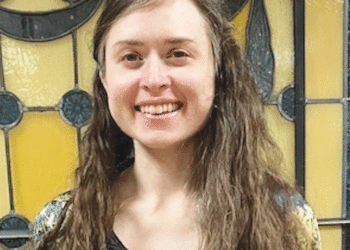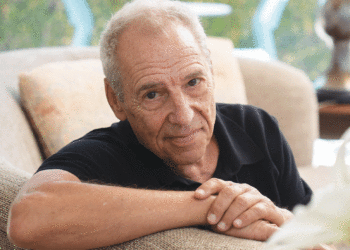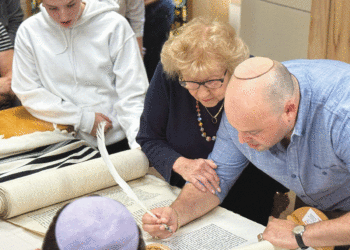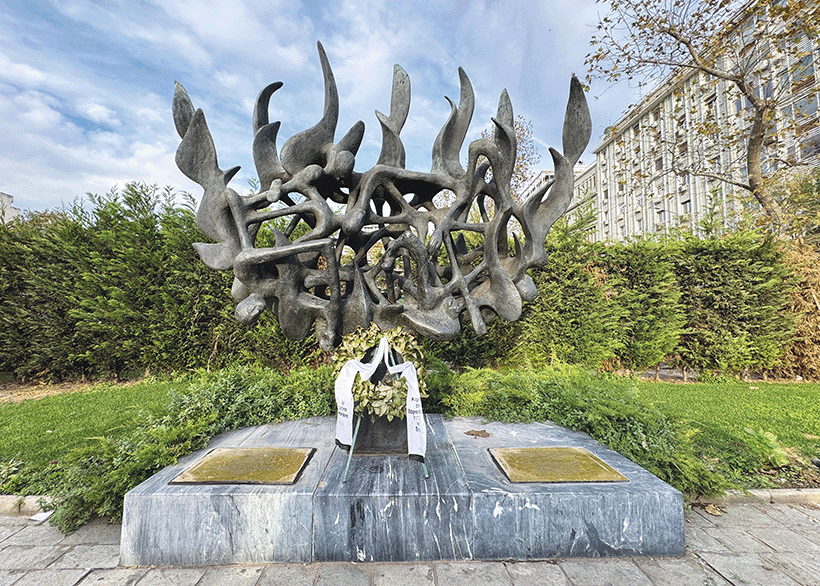
By ELANA WARREN / Assistant Editor
Driving away from the Athens airport, the first things you notice, aside from the warmer weather, are the mountainous features of the terrain. As you get moving you see more city features, though not quite like Minneapolis or St. Paul — except for the random TGI Friday’s.
Restaurant hosts stand at the edge of their vast outdoor seating sections that dip into the stone sidewalks, inviting you to come in. The walkable city has large contemporary shops but also old churches and structures. And then there are the ancient sites, like the Acropolis, home of the Parthenon, all in one city.
Around the Jewish World
Our hotel was in the city center. As I arrived, a solidarity rally for Palestine was just five blocks away in front of the Parliament of Greece. It was an interesting time to be in Greece learning about its Jewish history, both the beautiful and the tragic, as history was taking place just across the Mediterranean Sea in Israel.
Did you know there was Jewish history in Greece? Were you taught that 87 percent of Greece’s Jewish population perished in the Holocaust? And 96 percent in just the city of Thessaloniki? Or that Thessaloniki was once considered the Jerusalem of the Balkans?
I traveled to Greece with a cohort of Twin Cities Jewish young adults on a trip organized by the Joint Distribution Committee (JDC) Entwine, in partnership with YALA Twin Cities. The purpose of Entwine trips is for participants to connect with the global Jewish community and learn about the JDC’s global impact work.
The Jewish community first came to Greece in the fourth century and in Thessaloniki grew to be the largest ethnic group, with 70,000 Jews at the beginning of the 20th century, bigger than the Muslim and Greek communities. The city suffered a fire in 1917 that destroyed 30 synagogues and led to people leaving the city, but in 1940 Thessaloniki still had the largest Jewish population in Greece, with 52,000 of Greece’s 70,000 Jews, according to the 1940 census. Then 48,000 of them were lost to the Holocaust, mostly at Auschwitz-Birkenau.
There are now 5,000 Jews in Greece, with almost 3,000 in Athens and about 1,000 in Thessaloniki. Our tour guide said all Greek Jews are descendants of Holocaust survivors. There are the Romaniote Jews, indigenous to Greece, and there’s also a great Sephardi presence.
Two synagogues stand in Athens; both survived the Holocaust because the Nazi presence came to Greece late in the war and because the Nazis used the buildings for storage. You can still see markings from bullets in the white marble walls of Beth Shalom Synagogue, the principal synagogue of Athens.
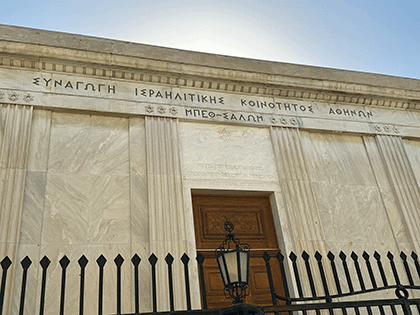
At Beth Shalom, Rabbi Gabriel Negrin, chief rabbi of the Jewish Community of Athens, told the story of Rabbi Elias Barzilai, the chief rabbi during the war, who burned the synagogue archives to keep the list of Greek Jews from the Nazis. The Greek Orthodox archbishop, who had a list of non-Christians, also refused to share his list and worked with the police chief to provide false identities for Jews.
From the bima, Negrin also spoke of Jewish life in Athens today. He stressed that all of Athens’ Jews automatically have membership in the Jewish community, which is a legal entity under state law. He said you can have many chosen brotherhoods (like congregations), but there is only one Jewish community, and it comprises all Jews.
That idea carries into the work of the Jewish Community of Athens, led by Director Taly Mair. The JCA offers social services, like our JFCS and JFS do; education, including a Jewish day school like Heilicher; security (supported mainly by the Jewish Agency for Israel), like the JCRC does; youth programs; Jewish cultural programs; and more.
We visited seniors at JCA’s Warm House, a program that provides the elderly, including the isolated, with activities, a warm meal and community three times a week. The Warm House even brings in doctors to make medical visits more accessible. Since October, the community center also has programs on Wednesdays for displaced Israelis staying in Greece.
Three days after the start of the Israel-Hamas war, the Jewish community had set up a hotline, and within a week, Israeli children were welcomed into the Lauder Foundation-supported Athens Jewish Community School.
It’s worth mentioning the global connections, and not just between Greece and Israel. The welfare and social services program receives funding from the JDC and Jewish Federations of North America, and the Warm House is a pilot program of the JDC.
In addition to visiting all the aforementioned Jewish sites in Athens and the Jewish Museum of Athens, we toured the general Greek sites and museums. Many people in my cohort compared walking around Athens to being in Jerusalem — it’s a modern city, but it also has ancient ruins. We walked by the ancient Agora, and the view from the rooftop of our hotel (and from many spots around the city center) features the Acropolis, with the Parthenon lit up at night.
The Jerusalem of the Balkans
We spent the second part of our trip in Thessaloniki, known in Jewish history as Salonika. Our tour guide, Hella Kounio-Matalon, is the daughter and granddaughter of Holocaust survivors. Her mother was a hidden child who survived because she could speak Greek, not just her parents’ language, Ladino. Her father and his family survived concentration camps because they could speak German — among other seeming miracles that led to their survival.
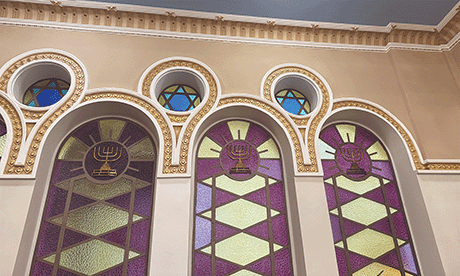
Hearing from someone with such knowledge and personal ties to the city and its history made my time in Thessaloniki especially impactful. She shared with us stories of her father’s family’s survival, at the train tracks where they were deported. At the Monasteries Synagogue, she told us the story of the rabbi standing in that very synagogue and addressing his congregation, telling them to leave for Poland. The synagogue looks the same as it did then, she said, with the original walls but recreated glass windows, as the originals were blown in. It’s unclear whether the rabbi knew his information about Poland being safe was false.
The once booming Jewish population in Thessaloniki led to Yom Kippur being declared a holiday in 1933, which in turn led to jealousy, one of the things that began spurring antisemitism. We visited Eleftherias Square, Liberty Square, where in 1942 Nazis ordered 9,000 Jewish men ages 18 to 45 into the square to endure forced exercise in the heat and suffer torture and humiliation, just to be recorded and led away to forced labor camps.
The Jewish community paid the Nazis 2.5 billion drachmas (approximately $90 million today) to free them, just for the Nazis to later come back for them and destroy the Jewish businesses and cemetery. Just three months after the Nazis released the Jewish people, deportations started. The Jews were sent to Auschwitz-Birkenau and their deaths, over five months and 19 deportations. The Thessaloniki people were ignorant of where the Nazis were sending them and the fate that awaited them.
The Nazis occupied Athens months after the occupation of Thessaloniki, and Rabbi Barzilai, having seen what happened in Salonika, told his people to hide in the mountains in September 1943. In April 1944, the Athenian Jews were suffering from hunger, and the Nazis tricked 800 of them to come out to receive matzo, meat and wine for seder, and many were trapped and deported.
Kounio-Matalon said, “It’s our obligation to remember,” and that’s why I share my experience in Greece.
Her whole family obliged too: Her paternal grandfather, Salvator Kounio, photographed liberation of camps after being liberated himself. And her father, Heinz Kounio, also a concentration camp survivor, compiled the names and information about 37,000 of the 50,000 Jewish Thessaloniki victims of the Holocaust. He also published a book of memories and documents, A Liter of Soup and Sixty Grams of Bread: The Diary of Prisoner Number 109565.
Kounio-Matalon sent a message to one of my group leaders after we’d returned home: “A group of young Jewish leaders, visiting my community, which is small today, so different from the glorious past, filled me with hope and awareness that people abroad, in larger and more powerful communities, care not only for Israel but for smaller Jewish communities, like ours in the Diaspora. Speaking with many of them filled me with ideas and inspiration to do more in my community as well.”
She added, “Also, the opportunity which was given to me, to speak to them about the so important local Jewish history and my personal stories, is for me precious. … Let us stay united and aware of the diverse Jewish history.”
My group of local Jews in our 20s and 30s met our Jewish peers in both Athens and Thessaloniki. One Thessalonian woman said she doesn’t think the Thessaloniki Jewish community will survive long, as young adults leave for school and work opportunities, and because there aren’t many of them to begin with, making marrying within the faith harder.
But then there are people like Hella fighting for the community. Back in Athens, the passion of the volunteers and staff who run community programs and work to keep the Jewish community of Athens and greater Greece alive was remarkable.
***
Elana Warren’s travels in Greece were partially subsidized by the Minneapolis Jewish Federation and the American Jewish World. The organized trip was subsidized for all participants by JDC Entwine and the Minneapolis Jewish Federation.
(American Jewish World, January 2024)











